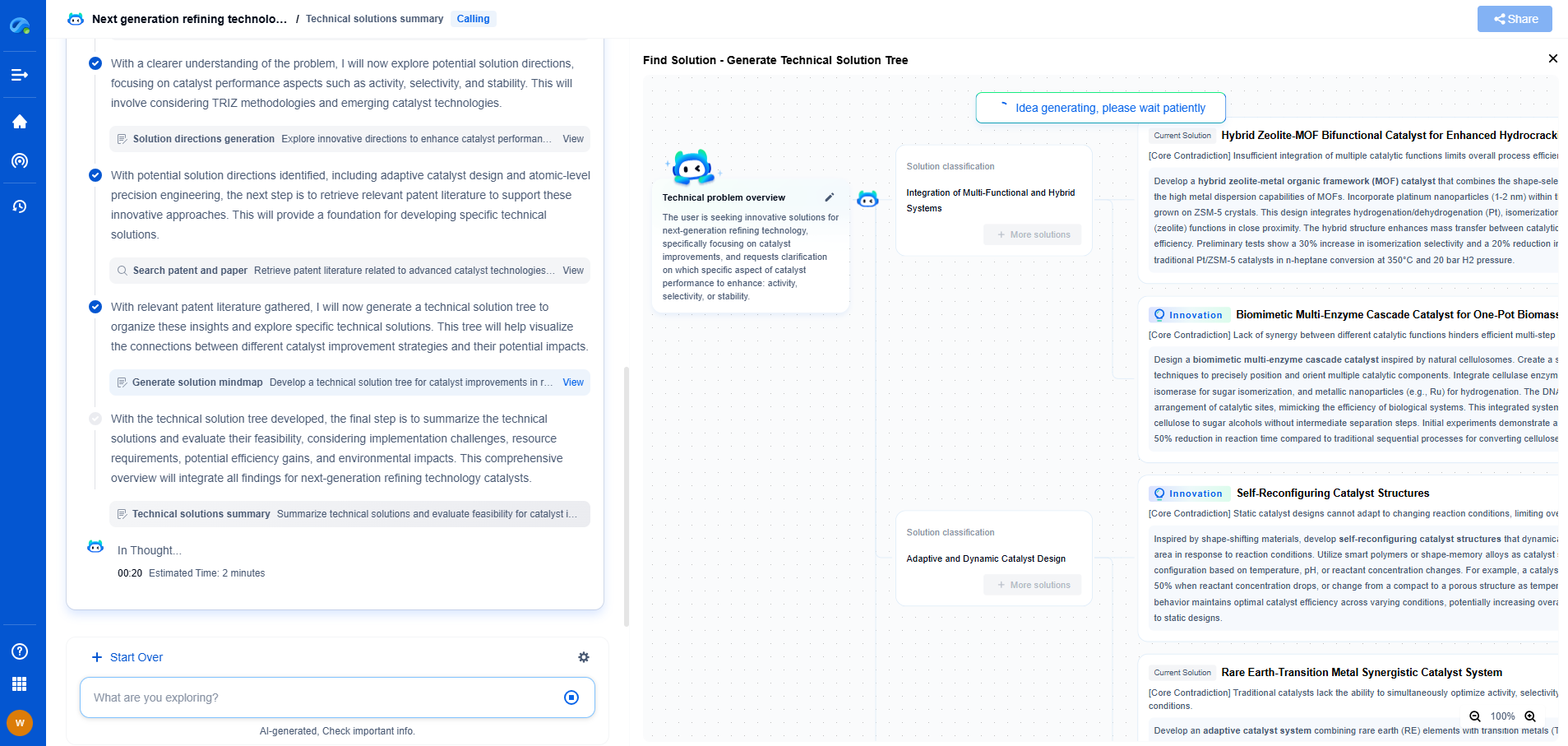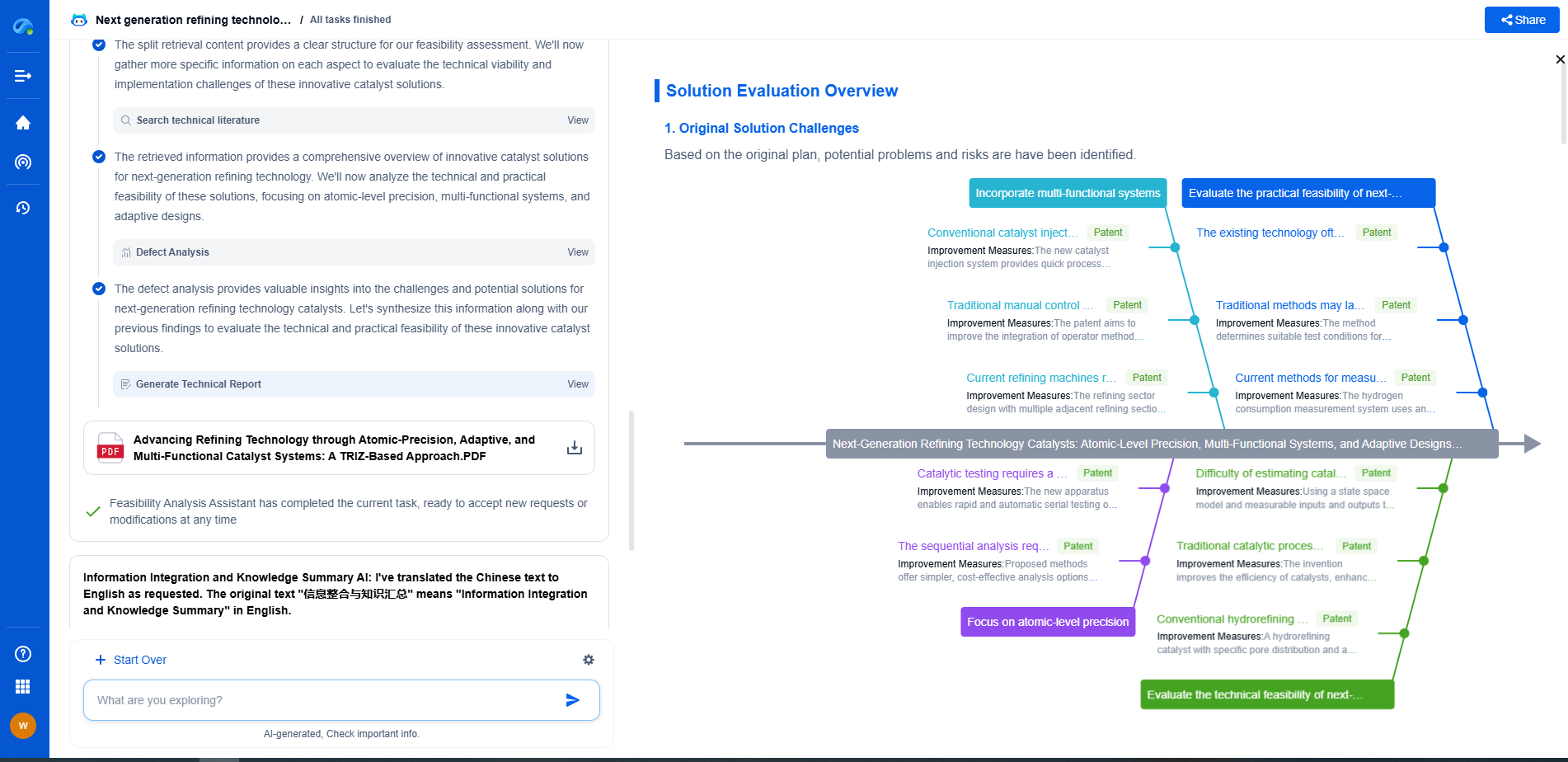How Blade Shape Optimization Improves Energy Capture
JUN 26, 2025 |
The quest for harnessing energy efficiently has never been more crucial. With the growing demand for renewable energy sources, optimizing the mechanisms that capture energy is essential. One area of significant advancement is blade shape optimization in wind turbines and hydrokinetic devices. By fine-tuning the design, engineers can substantially enhance energy capture, leading to more sustainable and effective solutions.
The Science Behind Blade Shape
At its core, blade shape optimization involves modifying the design of blades to improve aerodynamic or hydrodynamic performance. The primary goal here is to maximize the interaction between the blade and the moving fluid—whether air or water—so that the energy extracted from the flow is maximized.
In wind turbines, for example, the blade shape is crucial because it determines the lift and drag forces acting on the blade. A well-optimized blade shape will increase the lift-to-drag ratio, allowing the turbine to convert more wind energy into mechanical energy. This means that turbines can operate efficiently even at lower wind speeds, increasing their overall energy yield.
Computational Tools and Techniques
Advancements in computational fluid dynamics (CFD) have been instrumental in the development of optimized blade shapes. These sophisticated simulations allow engineers to model the complex interactions between fluid flows and blade surfaces. By analyzing these interactions, they can iteratively improve the blade design to achieve optimal performance.
Multi-objective optimization algorithms are also used extensively. These algorithms consider multiple factors, such as maximizing energy capture while minimizing material usage and stress on the blades. This ensures that the final design is not only efficient but also durable and cost-effective.
Applications in Different Energy Sectors
Blade shape optimization is not confined to just wind energy. In hydrokinetic energy, for instance, optimizing the shape of turbine blades can significantly enhance the extraction of energy from ocean currents, tidal flows, and rivers. These environments present unique challenges, such as varying flow speeds and directions, which make optimization even more critical.
In aviation, blade shape optimization is also applied to propellers and jet engine turbines. Although the primary goal in these applications is to increase thrust or propulsion efficiency, the underlying principles of fluid dynamics remain similar. By refining blade shapes, engineers can reduce fuel consumption and emissions, contributing to more sustainable air travel.
The Impact on Energy Efficiency
The benefits of blade shape optimization extend beyond increased energy capture. By optimizing blade design, engineers can also reduce the wear and tear on turbines, leading to longer lifespans and lower maintenance costs. Additionally, more efficient energy capture reduces the need for additional turbines or installations, thus minimizing the environmental footprint of renewable energy projects.
Furthermore, optimized blades can operate efficiently at a wider range of wind or water flow speeds. This flexibility makes renewable energy installations more resilient to varying environmental conditions, ensuring a stable energy supply.
Future Prospects and Innovations
The future of blade shape optimization holds exciting prospects. With ongoing advancements in materials science, engineers are experimenting with novel materials that can further enhance blade performance. Lightweight composites and biomimetic materials—those that mimic natural systems—are being explored for their potential to improve efficiency and durability.
Additionally, the integration of artificial intelligence and machine learning into the optimization process is becoming more prevalent. These technologies can analyze vast amounts of data from operational turbines to predict performance trends and suggest real-time adjustments to blade design, ensuring continuous improvement.
Conclusion
Blade shape optimization stands at the forefront of efforts to improve energy capture from renewable sources. By leveraging the latest technological advancements and scientific principles, engineers can design blades that not only maximize energy efficiency but also contribute to the sustainability and viability of renewable energy systems. As the world continues to transition towards cleaner energy, optimizing the tools that make this possible will remain a vital part of the journey.
Empower Your Wind Power Innovation with AI
In the fast-evolving landscape of wind turbine technology—where aerodynamic optimization, generator efficiency, and structural innovation are critical—staying ahead requires more than just expertise. It requires intelligent tools that accelerate R&D and protect your competitive edge.
Patsnap Eureka is your AI-powered research assistant, designed specifically for innovators like you working at the forefront of Wind Motors. Whether you're analyzing blade design trends, exploring novel gearbox architectures, or navigating complex global patent landscapes, Eureka streamlines the entire process with precision and speed.
👉 Experience how Patsnap Eureka can revolutionize your R&D and IP strategy. Request a demo today and power up your next breakthrough.
- R&D
- Intellectual Property
- Life Sciences
- Materials
- Tech Scout
- Unparalleled Data Quality
- Higher Quality Content
- 60% Fewer Hallucinations
Browse by: Latest US Patents, China's latest patents, Technical Efficacy Thesaurus, Application Domain, Technology Topic, Popular Technical Reports.
© 2025 PatSnap. All rights reserved.Legal|Privacy policy|Modern Slavery Act Transparency Statement|Sitemap|About US| Contact US: help@patsnap.com

